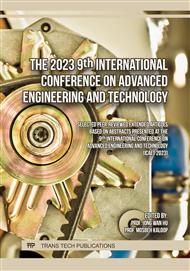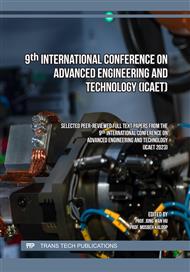[1]
Y. Liao, F. Deschamps, E. de F.R. Loures, L.F.P. Ramos, Past, present and future of Industry 4.0 - a systematic literature review and research agenda proposal, Int J Prod Res. 55 (2017) 3609–3629.
DOI: 10.1080/00207543.2017.1308576
Google Scholar
[2]
M.Z. Akkad, T. Bányai, Applying Sustainable Logistics in Industry 4.0 Era, Lecture Notes in Mechanical Engineering. 22 (2021) 222–234.
DOI: 10.1007/978-981-15-9529-5_19
Google Scholar
[3]
S.O. Gustavsson, Flexibility and productivity in complex production processes, Int J Prod Res. 22 (2007) 801–808.
DOI: 10.1080/00207548408942500
Google Scholar
[4]
K. Bakon, T. Holczinger, Z. Sule, S. Jasko, J. Abonyi, Scheduling Under Uncertainty for Industry 4.0 and 5.0, IEEE Access. 10 (2022) 74977–75017.
DOI: 10.1109/ACCESS.2022.3191426
Google Scholar
[5]
V.N. Kostrov, O.N. Klyuchev, Local systems in an automated glass production complex, Glass and Ceramics. 35 (1978) 340–342.
DOI: 10.1007/bf00697886
Google Scholar
[6]
A.G. Aganbegyan, M.K. Bandman, Territorial production complexes as integrated systems: Theory and practice, Geoforum. 15 (1984) 25–32. https://doi.org/10.1016/0016-7185 (84)90007-1.
DOI: 10.1016/0016-7185(84)90007-1
Google Scholar
[7]
A.D.M. van de Ven, L. Florusse, Integrated time-functions and cost-functions as a basis for analysis of complex production systems, Engineering Costs and Production Economics. 21 (1991) 95–103.
DOI: 10.1016/0167-188X(91)90023-U
Google Scholar
[8]
O. Kapliński, M. MiŁosz, Reliability of complex production systems, Civil Engineering Systems. 13 (1996) 61–73.
DOI: 10.1080/02630259608970186
Google Scholar
[9]
L. Dammacco, R. Carli, V. Lazazzera, M. Fiorentino, M. Dotoli, Designing complex manufacturing systems by virtual reality: A novel approach and its application to the virtual commissioning of a production line, Comput Ind. 143 (2022) 103761.
DOI: 10.1016/J.COMPIND.2022.103761
Google Scholar
[10]
A. Mamudu, F. Khan, S. Zendehboudi, S. Adedigba, Dynamic risk modeling of complex hydrocarbon production systems, Process Safety and Environmental Protection. 151 (2021) 71–84.
DOI: 10.1016/J.PSEP.2021.04.046
Google Scholar
[11]
A. Russell, S. Taghipour, Multi-objective optimization of complex scheduling problems in low-volume low-variety production systems, Int J Prod Econ. 208 (2019) 1–16.
DOI: 10.1016/J.IJPE.2018.11.005
Google Scholar
[12]
M.Z. Akkad, T. Bányai, Cyber-physical waste collection system: A logistics approach, in: Solutions for Sustainable Development - Proceedings of the 1st International Conference on Engineering Solutions for Sustainable Development, ICESSD 2019, CRC Press, 2020: p.160–168.
DOI: 10.1201/9780367824037-21
Google Scholar
[13]
P. Dobos, P. Tamás, B. Illés, R. Balogh, Application possibilities of the Big Data concept in Industry 4.0, IOP Conf Ser Mater Sci Eng. 448 (2018).
DOI: 10.1088/1757-899X/448/1/012011
Google Scholar
[14]
E. Glistau, N.I.C. Machado, Industry 4.0, logistics 4.0 and materials - Chances and solutions, Materials Science Forum. 919 (2018) 307–314. https://doi.org/.
DOI: 10.4028/WWW.SCIENTIFIC.NET/MSF.919.307
Google Scholar
[15]
C. Felho, J. Kundrak, CAD-Based Modelling of Surface Roughness in Face Milling, (2014).
Google Scholar
[16]
Y. Lu, Industry 4.0: A survey on technologies, applications and open research issues, J Ind Inf Integr. 6 (2017) 1–10.
DOI: 10.1016/J.JII.2017.04.005
Google Scholar
[17]
M.Z. Akkad, J. Šebo, T. Bányai, Investigation of the Industry 4.0 Technologies Adoption Effect on Circular Economy, Sustainability 2022, Vol. 14, Page 12815. 14 (2022) 12815.
DOI: 10.3390/SU141912815
Google Scholar
[18]
3 Major Differences Between an MES and ERP System | Pyramid Solutions, (n.d.). https://pyramidsolutions.com/intelligent-manufacturing/blog-im/3-differences-between-mes-and-erp/.
Google Scholar
[19]
W.J. Lee, G.P. Mendis, J.W. Sutherland, Development of an Intelligent Tool Condition Monitoring System to Identify Manufacturing Tradeoffs and Optimal Machining Conditions, Procedia Manuf. 33 (2019) 256–263.
DOI: 10.1016/J.PROMFG.2019.04.031
Google Scholar
[20]
R. Lachmayer, I. Mozgova, W. Scheidel, An Approach to Describe Gentelligent Components in their Life Cycle, Procedia Technology. 26 (2016) 199–206. https://doi.org/.
DOI: 10.1016/J.PROTCY.2016.08.027
Google Scholar



